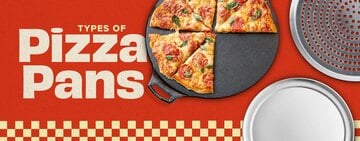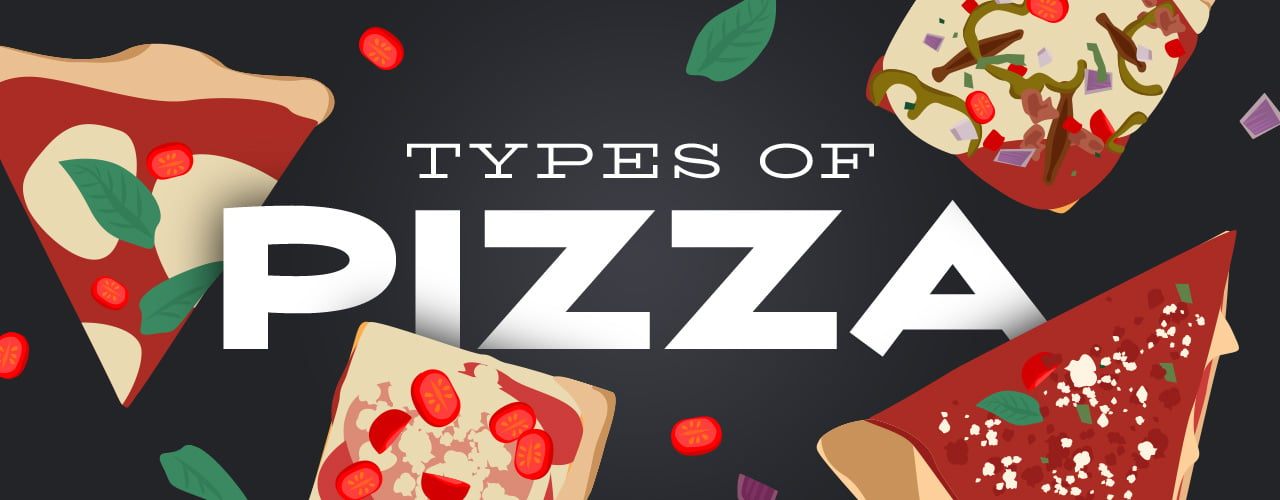
Since its humble beginnings in Italy, pizza has gone through numerous transformations to become the dish that so many people know and love today. But if you’re just opening your first pizza place or want to add a pizza oven to your restaurant's patio, it can be difficult to decide what style of pizza your restaurant will make. We discuss the different types of pizza, their history, and what you’ll need to make them so you can start serving up delicious slices to your guests.
Shop All Pizza Supplies and EquipmentPizza Styles
Check out our video showcasing the most popular pizza styles. For a skimmable guide to pizza styles, skip to our helpful infographic.
1. Neapolitan Style Pizza
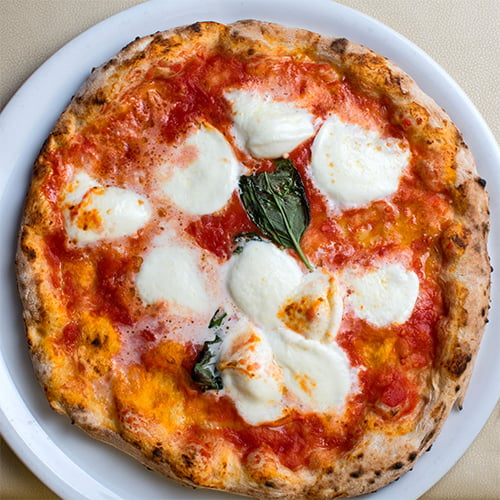
Neapolitan is the original pizza. This delicious pie dates all the way back to the 18th century in Naples, Italy. During this time, the poorer citizens of this seaside city frequently purchased food that was cheap and could be eaten quickly. Luckily for them, Neapolitan pizza was affordable and readily available through numerous street vendors.
Types of Neapolitan Pizza
Today there are three official variants of Neapolitan pizza:
Pizza Marinara: Features tomatoes, garlic, oregano, and extra virgin olive oil.
Pizza Margherita: Features tomatoes, sliced mozzarella, basil, and extra virgin olive oil.
Pizza Margherita Extra: Features tomatoes, mozzarella from Campania, basil, and extra virgin olive oil.
Traditional Neapolitan Pizza Toppings:
The typical Neapolitan pizza toppings are fresh mozzarella, tomatoes, basil leaves, oregano, and olive oil. Since Neapolitan pizza is thin, it isn't designed to handle the weight of too many toppings. In fact, Neapolitan pizza is so thin that it's typically eaten with a fork and knife.
Neapolitan Pizza Baking Suggestions:
Many people will tell you that in order to make "real" Neapolitan pizza, it must be baked in a wood-burning oven that's heated anywhere from 800 - 1,000 degrees Fahrenheit, similar to how it was made many years ago. Baking the pie at this high of a temperature only takes around 70-90 seconds to fully cook.
2. Chicago Style Pizza
Chicago pizza, also called deep-dish pizza, gets its name from the city it was invented in. During the early 1900s, Italian immigrants in the windy city were searching for something similar to the Neapolitan pizza that they knew and loved. Instead of imitating the notoriously thin pie, Ike Sewell had something else in mind. He created a pizza with a thick crust that had raised edges, similar to a pie, and ingredients in reverse, with slices of mozzarella lining the dough followed by meat and vegetables, and then topped with a can of crushed tomatoes. This original creation led Sewell to create the now-famous chain restaurant, Pizzeria Uno.

Traditional Chicago Pizza Toppings:
Generally, the toppings for Chicago pizza are mozzarella, ground beef, sausage, pepperoni, onion, mushrooms, and green peppers, placed underneath the tomato sauce. Some locations will finish off their pizzas with a sprinkle of Parmesan cheese across the tomato sauce.
Chicago Pizza Baking Suggestions:
To easily get a Chicago pizza out of the pan, it's important to wipe the pan down with oil. Adding oil to the pan also helps to make the base of the dough a bit crispier. Since there are more toppings and dough, baking a deep dish pizza can be a lengthier process, with a baking time of 30 - 35 minutes.
3. New York Style Pizza

With its characteristic large, foldable slices and crispy outer crust, New York pizza is one of America’s most famous regional pizza types. Originally a variation of Neapolitan pizza, the New York slice has taken on fame all its own, with some saying its unique flavor has to do with the minerals present in New York’s tap water supply.
Traditional New York Pizza Toppings:
New York pizza usually features tomato sauce and mozzarella cheese. Unlike its thin crust counterpart, the Neapolitan, New York pizzas can handle a wide range of additional toppings, from pepperoni and sausage to mushrooms and anchovies. While this type of pizza can have virtually anything added to it, it's common to find pizza lovers topping New York pizza with condiments like oregano, red pepper flakes, Parmesan cheese, and garlic powder.
New York Pizza Baking Suggestions:
Just like the Neapolitan pizza, many will tell you that for a New York pizza to be authentic, it has to be cooked in a wood or coal-burning oven. Today, many people use gas deck ovens to bake them, which creates the same delicious and crispy result in 12-15 minutes.
4. Sicilian Style Pizza
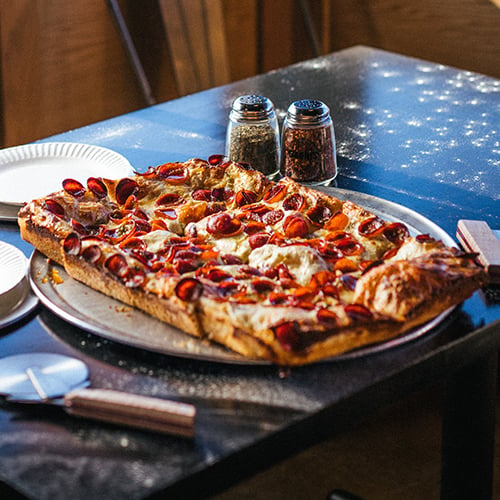
Sicilian pizza, also known as "sfincione," provides a thick cut of pizza with pillowy dough, a crunchy crust, and robust tomato sauce. This square-cut pizza is served with or without cheese, and often with the cheese underneath the sauce to prevent the pie from becoming soggy. Sicilian pizza was brought to America in the 19th century by Sicilian immigrants and became popular in the United States after the Second World War.
Traditional Sicilian Pizza Toppings:
Sicilian pizzas are often topped with bits of tomato, onion, anchovies, and herbs.
Sicilian Pizza Baking Suggestions:
To bake Sicilian pizza, line your pan with an olive oil blend and press the crust in. The oven's temperature is usually set to 450 degrees Fahrenheit with the crust getting a head start on baking, usually for 15-20 minutes. The toppings are then added with an additional bake time of 10-15 minutes, or until golden brown.
Back to Top
5. Greek Style Pizza
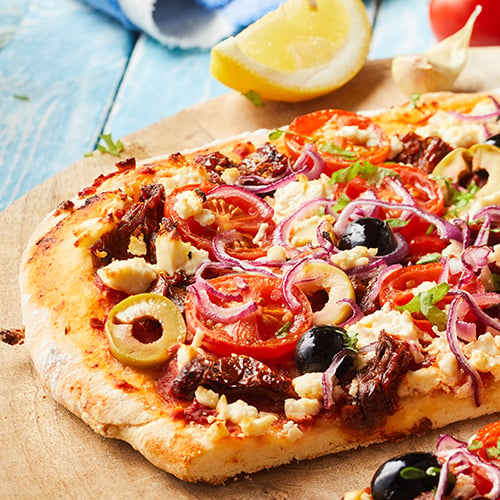
Greek pizza was created by Greek immigrants who came to America and were introduced to Italian pizza. Greek pizza, trendy in the New England states, features a thick and chewy crust cooked in shallow, oiled pans, resulting in a nearly deep-fried bottom. While this style has a crust that is puffier and chewier than thin crust pizzas, it’s not quite as thick as a deep-dish or Sicilian crust.
Traditional Greek Pizza Toppings:
Greek pizza is usually heavier on the sauce than the cheese. The sauce typically has a tangy tomato paste with a strong oregano flavor. It is often only topped with cheese, which is usually a mix of cheeses like mozzarella, cheddar, or provolone. It may feature a variety of non-Greek or Greek toppings, such as feta cheese, black olives, and red onion.
Greek Pizza Baking Suggestions:
To get a puffy, chewy crust, Greek pizza is typically baked in a shallow, round pan that has been heavily coated in olive oil. Lining the pan with oil also allows the bottom of the dough to fry while it bakes. Greek pizza usually bakes in a 450-degree Fahrenheit oven for about 12-15 minutes.
6. California Style Pizza

California pizza, or gourmet pizza, is known for its unusual ingredients. This pizza got its start back in the late 1970s when Chef Ed LaDou began experimenting with pizza recipes in the classic Italian restaurant, Prego. He created a pizza with mustard, ricotta, pate, and red pepper, and by chance, served it to Wolfgang Puck. Impressed with LaDou’s innovative pie, Puck invited him to be the head pizza chef at his restaurant. It was here that LaDou came up with over 250 unique pizza recipes that eventually formed the menu of the chain restaurant California Pizza Kitchen.
Traditional California Pizza Toppings:
When it comes to California pizza, there's no such thing as traditional toppings. This lack of specificity allows you to get inventive. You can include anything from chicken and artichokes to goat cheese and egg.
California Pizza Baking Suggestions:
California pizza typically follows the same baking style as New York pizza, where it can be baked in a wood or charcoal oven for a minute or so, or in a deck oven for 12-15 minutes.
7. Detroit Style Pizza

Reflecting the city’s deep ties to the auto industry, Detroit pizza was originally baked in a square automotive parts pan in the 1940s. Detroit pizza is first topped with pepperoni, followed by brick cheese (a semi-hard cheese named after the bricks used to press the curds) which is spread to the very edges of the pan, yielding a caramelized cheese perimeter. The sauce is then spooned over the pizza, an order similar to Chicago pizza. This pizza features a thick, extra-crispy crust that is tender and airy on the inside.
Traditional Detroit Pizza Toppings:
Detroit pizza traditionally features pepperoni, brick cheese (usually Wisconsin brick cheese), and tomato sauce. Other typical toppings include mushrooms and olives.
Detroit Pizza Baking Suggestions:
Detroit pizza traditionally uses a jelly roll baking pan to get its deep, rectangular shape. There is a specific way to shape the dough into this pan, which requires pressing the air out from the dough while pushing the dough to the edges of the pan. When adding the cheese, make sure to spread it generously across the dough and to the edges for a caramelized perimeter. Cook at the highest temperature setting (500 to 550 degrees Fahrenheit) for 10-15 minutes. Cut your slices in squares for authenticity!
8. St. Louis Style Pizza
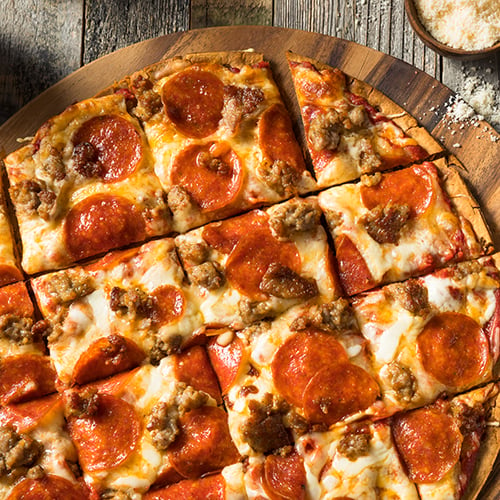
Looking for a light slice? St. Louis pizza features a thin crust with a cracker-like consistency that is made without yeast. Due to the crispy crust, St. Louis pizza is usually cut into 3- or 4-inch rectangles, known as "party" or "tavern" cut. This pizza features Provel processed cheese, which is a gooey combination of cheddar, Swiss, and provolone cheeses. St. Louis received an influx of Italian immigrants in the 19th century who were looking for employment opportunities. The Italian community, largely from Milan and Sicily, created the St. Louis pizza. Its sweet sauce is reminiscent of the Sicilian influence.
Traditional St. Louis Pizza Toppings:
St. Louis pizza features Provel cheese and a sweeter tomato sauce with a hefty dosage of oregano. Because of its firm crust, St. Louis pizza can support several toppings of your choice.
St. Louis Pizza Baking Suggestions:
St. Louis pizza requires a pizza stone or a thin baking sheet to achieve its famously crackly crust. Place on the lowest rack position in a 425-degree Fahrenheit oven for 8-12 minutes.
Back to Top
Types of Pizza Crust
While the dough and crust of a pizza can fly under people’s radar, they are the foundation of creating a delicious pizza. There are several ways to mold and shape your pizza dough and crust, but the two most popular styles are thin and thick crusts.
Thin Crust Pizza

Thin crust pizzas are slimmer in the center where the sauce, cheese, and ingredients are placed, but lead up to a crunchier edge. To get thinner dough, the key is to gently stretch out the dough to form the edges. Pizzas with thin crusts, like Neapolitan and New York, often don't have many toppings because they can’t handle the weight. If you want to add more toppings to your pie, you can still utilize a thin crust. To do so, simply make the center of the pie a bit thicker.
Thick Crust Pizza
Thick crust is thick throughout to handle the weight of the sauce and toppings. Typically, the crust can range in thickness anywhere from 1/8 to 1/4 inch. Since thick crust pizzas, like Chicago and Sicilian, have edges to contain all the sauce, cheese, and toppings, the crust is generally rolled out on a cutting board and molded into the shape of the pan that is used to bake it.
Supplies and Equipment for Different Styles of Pizza
Just like each pizza is different, so are the supplies and equipment you'll need to make them. Each pizza requires different equipment and ingredients depending on the style of pizza you will make. General pizza supplies consist of convection ovens, pizza cutters, pizza peels, and bulk spices. Certain specialty pizzas require specific types of pizza pans or screens to bake with. For example, New York and California pizzas are traditionally made on a pizza screen and served on a coupe pizza pan, and Chicago pizzas are baked in a deep dish or cast iron pan. If you are looking to bake the perfect specialty pizza, make sure you have the right supplies to create your desired type of pizza.

Back to Top
Our list of different types of pizza will help you narrow down what styles you want to add to your menu. From a simple cheese pizza to your own custom pie, pizza presented in the right pizza box is a great way to show off your culinary skills.




